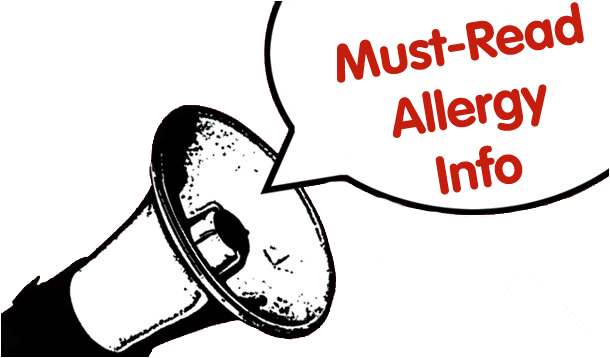
Creating balanced, healthy family meals can seem challenging and even overwhelming at the best of times, but even more challenging if one of your children has a severe food allergy. This is a common problem in Canada, as it is estimated that as many as 1.3 million Canadians suffer from life-threatening food allergies, and these numbers are likely on the rise.
For those who have severe food allergies, the protein in particular foods is mistakenly identified by the immune system as being harmful. The first time someone is exposed to one of these proteins, their immune system responds by producing antibodies. As a result, the next time that person is exposed to that protein, antibodies and chemicals such as histamine are released causing a reaction in the body which could effect the gastrointestinal tract, the respiratory system, the cardiovascular system, or the skin.
As a Registered Dietitian, I often counsel parents of kids with severe food allergies on how to ensure that their family meals are safe and free of harmful allergens, as well as healthy and tasty. Most of these parents not only worry about their kids avoiding their allergy triggers, but also about ensuring that their child eats a balanced and nutritious diet. After all, some of these kids have to remove entire food groups from their diets to avoid an allergic reaction.
So, how do you ensure that your allergic child doesn't miss out on key nutrients? And how do you protect them from their allergy triggers both at home and away from home?
Unfortunately, some of the most convenient and healthy foods contain the most common allergens. Peanuts, tree nuts, eggs, milk, and fish are among them. Here are the important nutrients found in these foods and how to receive them elsewhere:
Note: Please keep in mind that if your child has a severe allergy to peanuts, tree nuts or seeds, make sure that you read the label carefully to ensure the allergic oils are not in the ingredients list, or better yet, make it yourself and use an oil that is not an allergen to your child!
Having a severe food allergy means that you and your child need to be careful about food choices, not only at the grocery store, but also at school, at friends' houses or at a restaurant depending on where your child is eating.
Cross-contamination can occur in the manufacturing facility, at the grocery store, or at home. It occurs when a "safe" food picks up traces of an allergen from an "unsafe" food, usually from utensils or sharing of the same appliances. If you are reading a food label and notice that there are warning labels that the food may have been contaminated with your child's allergen during manufacturing such as 'may contain ...,' 'does contain...' or 'may have come into contact with...,' avoid that product just in case there has been any cross-contamination in the manufacturing facility.
Avoid buying foods from the deli counter as meats and cheeses are often cut with the same slicer. Also avoid buying food from bulk bins as someone could have used the scoop from a bin that contains allergens i.e. if you are allergic to nuts and buying flour, the scoop could have previously been used in a bin containing nuts.
When you are preparing your meal at home, it is important that you practice food safety, as even the tiniest amount of food can cause a severe allergic reaction. Be sure to wash your hands often, using a liquid or bar soap, or commercial hand wipes (not hand sanitizer). Clean all surfaces such as counters and tables thoroughly with a household cleaner and wash your utensils, pots, pans and cutting boards well with dish detergent and warm water. To avoid cross-contamination when you are preparing your meal at home, always prepare the allergen-free meal first, cover it and keep it away from other foods and any splatter that might result from cooking with allergen-containing foods.
Although it is not always possible for your child to completely avoid their allergy triggers, they can be prepared by making sure they have easy access to an EpiPen at all times. EpiPen (and EpiPen Jr) are meant for people who are at risk of a life threatening allergic reaction.
Remember to always replace your child's EpiPen before it expires. If you think you may need a reminder, you can register for the expiration reminder service at EpiPen.ca. If your child ever needs to use their EpiPen, make sure that he is transported to a hospital immediately afterwards for observation. It isn't uncommon for a repeat attack to happen within hours after exposure. In fact, it's important that he remains within close distance to a hospital for the next 48 hours.
 Severe allergies are on the rise in Canada.
Severe allergies are on the rise in Canada.
This is proudly sponsored by EpiPen®.
EpiPen.ca
The opinions expressed in this post are the opinions of the individual author and may not reflect the opinions of Pfizer Canada, the Canadian distributor of EpiPen. Pfizer Canada reviews all material to ensure medical accuracy of statements.
EpiPen® and EpiPen® Jr (epinephrine) Auto-Injectors are indicated for the emergency treatment of anaphylactic reactions in patients who are determined to be at increased risk for anaphylaxis, including individuals with a history of anaphylactic reactions. Selection of the appropriate dosage strength is determined according to patient body weight.
EpiPen® and EpiPen® Jr Auto-Injectors are designed as emergency supportive therapy only. They are not a replacement for subsequent medical or hospital care. After administration, patients should seek medical attention immediately or go to the emergency room. For the next 48 hours, patients must stay within close proximity to a healthcare facility or where they can call 911. To ensure this product is right for you, always read and follow the label. Please consult the Consumer Information leaflet in your product package for complete dosage and administration instructions.
© 2013 Pfizer Canada Inc., Kirkland, Quebec H9J 2M5 • Toll free: 1-877-EPIPEN1 (1-877-374-7361)
EpiPen®, EpiPen® Jr are registered trademarks of Mylan Inc. licensed exclusively to its wholly-owned affiliate, Mylan Specialty, L.P.; sub-licensee, Pfizer Canada Inc., Kirkland, Quebec H9J 2M5